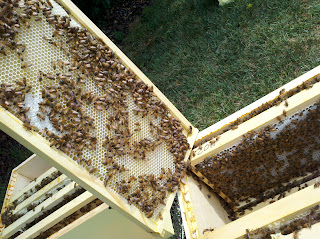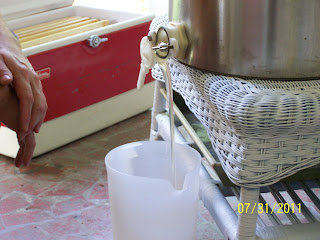written by Tom
Okay, it's been a week. This was the moment of truth. Had my girls touched the honey super I'd put on top in just one week? I'd been told they'll likely ignore the super. But I'm a gambling man, and I'd rather watch them ignore it than not try. If they went for it, I'll be a major step up for next spring's nectar flow and so much closer to honey. I know, I know, I'm working hive Boris like there's no tomorrow. Just don't tell the honey bee union, or I'm in trouble. Here you can see the two beetle jails I installed last week, also.
Woo-HOOO, they're going for it. This is the end frame. You can actually see they've begun drawing out the first two-thirds of the foundation from the top down. Once they finish, the comb will extend beyond the support wires I installed on each and every frame for added durability, helping the comb to be strong from within (which is great come honey extraction time).
Not just the first end frame, but frames two and three also were being drawn out. SUCCESS!
Every frame, EVERY SINGLE ONE, had been worked in the honey super in just one week. Holey moley! This was a favorite of mine, since they'd reached the bottom with fresh beeswax they'd secreted and shaped into comb. I was ecstatic to see so much success in such a short period of time. This further ensures my love of Russian bees. They do take longer to gear up than the Italian variety, but they also defy odds and are amazingly industrious when they want to be. Wow! I'm going to have honey next year, people (okay, okay, I'll calm down now)!!
After the super, I moved onto the top brood box. I'd taken three honey frames out of the top brood box over the past two weeks. Last weekend I noticed they'd not touched one of the replaced frames on the West end of the box. But in the last weekend they definitely started drawing it out. In fact, there was an odd chunk of burr comb on the face of this that I removed.
Another previously untouched frame, underway. I also noted the increased number of drone cells I saw capped, too. There are more male eggs being laid by the queen. Hive Boris now has plenty of useless, big honey-eating male bees wandering around. I believe I will requeen this hive when I make the split for hive Natasha. This should help ensure overwinter success for Boris and honey next spring. I removed another strange biscuit of comb that was attached to this frame, which two weeks ago was blank. More success!
They're prepping for autumn and winter well, with lots of simple syrup honey on the brood box frames.
Lots of bees greeted me in the top brood box, and lots of comb.
I only checked the top box, not the bottom. I'm always wondering "is she still in there?" about the queen. More capped brood in a nice pattern, lots of honey stores, and drone cells out the outlying edges on this one. She'd worked the top box nine days ago. The hive was unusually calm and not at all defensive. I took all this as a good sign, and that her highness is alive and well.
And here's a shot of the last two frames, which two weeks ago were blank after I'd removed honey frames. These girls had fully drawn out these big deep frames. They're ready for food stores and eggs. Hive Boris has been working at full speed, in direct full sun with highs close to or hitting the 100-degree mark. This hive is boiling over with bees, and ready to split.
I am convinced the full sun has kept beetles and moths at bay, especially the beetles. Just in case, last week I put in four beetle traps. I've only seen three small hive beetles this season, and three wax moths outside the hive trying to get in. This week I saw no moths at all. But this beetle jail managed to nab one of the bad guys. The bees enjoy chasing the beetles into the traps, which contain vegetable oil and kill the beetles. They'd also begun drawing out this end frame as well.
Now, if I was serious about splitting, I'd have to get my hands dirty. This wasn't necessary now. I could just let the bees rob the honey frames over several days. That just seems so unseemly to me. And I needed to get my extracting equipment in order. So why not spin out those four frames, get my hands dirty a bit and have them ready for Hive Natasha's queen to lay in? So out came the steam cleaner.
Doing this for the first time, in my own setup, on my own screened in back porch was wonderful. It took a while to clean and prepare, but once I did so, it was butterflies and excitement to remove those first cappings!
My tangential bench extractor can handle two deep frames at a time. After freezing the frames for about a week each, I'd moved them to my awesome, vintage Coleman cooler I inherited from my late dad. The cooler will hold nine deep frames of comb. It kept them safe and sound until I could extract.
It also makes for a great bench for this, well, bench extractor.
I spun and spun, but it didn't take much for the extractor to do each side (with tangentials, you have to spin out one side, rotate the frames and then spin the other). It was a lovely Sunday afternoon. And then I opened the honey gate. Wow, look at that "honey" they'd made out of the simple syrup I'd been feeding them. collected 18 pounds, or a gallon and a half of syrup honey that I'll feed back to the bees via the top feeders.
It kept coming and coming. Yes!! This was a big deal. In just two months I'd gotten this far, and gotten the bees to prepare for next spring's nectar flow, and done a dry run of what it'd be like come honey time at T's Bees. Pretty cool. Next up, splitting and creating Hive Natasha.

















1 comment:
LOVE the excitement in your words :) Congratulations to T's Bees. I think that's a good name for your honey :)
Post a Comment